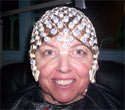April 03, 2009
Renzaglia Lecture to focus on brain wave research

Capacious -- Jeanne
M. Johnson models a
high-density electrode
net used to measure
brain waves. Johnson
will talk about the use
of brain waves in
treating speech and
language problems at
the annual Renzaglia
Lecture to be held at 7
p.m. Tuesday, April 14,
at the Student Center
on the Southern Illinois
University Carbondale
campus. (Photo
provided) Download
Photo Here
Johnson, who earned her doctorate from SIUC in 1986, has been using brain wave patterns to study speech and language perception. She will talk about neurophysiological discoveries she’s made in her research and how they might be used in treatment.
Johnson became interested in the study of brain waves after reconnecting with Dennis Molfese, a former SIUC psychologist now at the University of Louisville, at a conference where he talked about the research he and his wife, Victoria, do in this area.
“Brain waves tell us many things about speech and language including whether the auditory signal is reaching the cortex, the effectiveness with which neural networks are processing sound, whether similar sounds such as ‘ba,’ ‘da,’ ‘ga’ can be discriminated, the degree to which an unusual sound such as ‘ba, ba, ba, da, ba, ba’ can be detected and even whether an unexpected word in a sentence -- ‘Dogs like to dark’ (rather than ‘Dogs like to bark’) -- can be detected,” she wrote in an e-mail.
“An exciting application is to use measurements of these responses at a young age to predict outcomes at an older age like the Molfeses do.”
At the conference, Dennis Molfese reported that in a study conducted over a long period of time, he found he could predict with roughly 87 percent accuracy which babies would develop dyslexia, a learning disability that interferes with the development of reading, writing and spelling skills, based on the babies’ brain waves. To collect the data, he uses a net of electrodes that fit like a cap over the head rather than the old-style devices that must be attached individually in a process that often winds up scraping the children’s tender skin.
Intrigued by the method’s predictive possibilities and its gentler approach to data collection, Johnson took a yearlong sabbatical from WSU to work in Molfese’s Louisville lab. There, she learned to use the technology and collected data to use in her own study of children with profound hearing problems who have had electronic devices that stimulate auditory nerves implanted deep within their ears.
“I want to know if we can predict soon after implantation which children will struggle more with language development,” she wrote.
“There is wide variability in language skills of children with implants. If we know who is more likely to have problems, we can develop interventions that target the problems sooner rather than waiting for several years until we see the children fail.”
